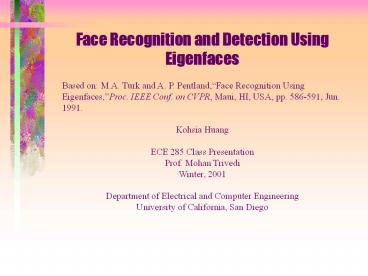Face Recognition and Detection Using Eigenfaces - PowerPoint PPT Presentation
Title:
Face Recognition and Detection Using Eigenfaces
Description:
Face Recognition and Detection Using Eigenfaces. Based on: M.A. ... on CVPR, Maui, HI, USA, pp. 586-591, Jun. 1991. Kohsia Huang. ECE 285 Class Presentation ... – PowerPoint PPT presentation
Number of Views:549
Avg rating:3.0/5.0
Title: Face Recognition and Detection Using Eigenfaces
1
Face Recognition and Detection Using
Eigenfaces Based on M.A. Turk and A. P.
Pentland,Face Recognition Using
Eigenfaces,Proc. IEEE Conf. on CVPR, Maui, HI,
USA, pp. 586-591, Jun. 1991. Kohsia Huang ECE
285 Class Presentation Prof. Mohan
Trivedi Winter, 2001 Department of Electrical
and Computer Engineering University of
California, San Diego
2
Background Works
- Detecting individual face features
- - Difficult to extend to non-frontal views
- - Insufficient representation for face
identification - Neural network approaches
- Multiresolution template matching
- Other methods
- - A. Pentland and T. Choudhury, Face
Recognition for Smart Environments, IEEE Comp.
Mag., pp. 50-55, Feb. 2000. - - P. Penev and J. Atick, Local Feature
Analysis A General Statistical Theory for Object
Representation, Network Compu. in Neural Syst.
7, pp. 477-500, Mar. 1996.
3
Interpretations of Eigenface
- Information Theory Extract relevant information
in face images, encode face images efficiently,
and compare individual face images. - Linear Algebra Find principle components of the
distribution of faces, which is the eigenvectors
of the covariance matrix of the training faces.
Principle components Features Eigenfaces.
4
Eigenface Algorithm
- Dimension reduction Face images can be
represented as a linear combination of the
eigenfaces. - Approximation The feature space or eigenface
space can be approximated by the eigenfaces
associated with the largest eigenvalues.
5
Eigenface Example
6
Procedure
- Initialization Obtain training faces and
calculate the eigenfaces. - Operating Calculate a set of weights by
projecting the test face into eigenface space. - Face detection If the image is close to the face
space, it is a face image. - Recognition If the test face is close to a
certain training face, it is recognized.
7
Formulation
8
Face Detection
- The error is the difference between the original
image and its projection image onto eigenface
space. - If the error is within a threshold, the image is
detected as a face image. - Efficient calculation available.
9
Face Recognition
- If the projection of face image onto eigenface
space is close to one training face, it is
identified as that training face. - Distance measure can be Euclidian distance.
10
Classification Summary
- Four possible patterns of an input image
- Near face space and its projection is near a face
class ? Recognized. - Near face space but its projection is distant
from all face classes ? Unknown face. - Distant from face space but its projection is
near a face class ? Not a face image. - Distant from face space and its projection is
distant from all face classes ? Not a face image.
11
Implementation
12
Accuracy
- 2500 face images
- Infinite thresholds 96 correct on lighting
variation, 85 on face orientation variation, 64
on size (zooming) variation. - Limited thresholds Adjust unknown rate to 20,
the above correct rates becomes 100, 94, and
74, respectively. - 25 face images
- 74 correct rate for controlled conditions.
13
Accuracy (Cont.)
- FERET Competition
- Standardized testing criteria.
- Not accurate enough for lower dimension
eigenface spaces. - Needs approximately 120 dimensions to compete
with local feature analysis.
























![Seminar: CSE 717 Soft[1] Biometric Traits in Face Recognition System PowerPoint PPT Presentation](https://s3.amazonaws.com/images.powershow.com/A1256656026vfqty.th0.jpg?_=20140117078)






